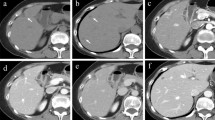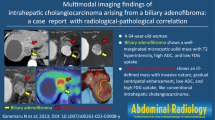Abstract
Biliary adenofibroma (BAF) is a rare, benign liver tumor. Herein, we report a case of BAF with histological features of imminent malignant changes. Ultrasound and CT revealed a solid 2.5-cm mass in the right liver lobe. The patient was asymptomatic and had no past medical history including liver disease. A general examination that included the abdomen and the laboratory data were normal. Because of the increase of its size, this tumor was surgically resected. Grossly, a 3.5-cm nodular mass abutted on the hepatic capsule was found, and its cut surface showed a well-circumscribed, whitish, and firm lesion that showed microcystic changes in the periphery and solid changes in the central parts. Histologically, the tumor showed a proliferation of tubulocystic structures embedded in a fibrous stroma. Microcysts were prevalent in the periphery, while tubular components with abundant fibrous stroma were in the central parts. The tubules were variably dilated and branched. This case closely resembled the previously reported cases of BAF, except that there were complicated papillary projections with fine fibrovascular cores in some of the microcysts and that the epithelial component in papillary projections showed dysplastic changes and increased cellular proliferative activities, implicating ominous features of imminent malignant changes. These dysplastic and papillary changes may be an intermediate lesion leading to malignancy, which have occasionally been reported in BAF.








Similar content being viewed by others
References
Tsui WMS, Loo KT, Chow LTC, Tse CCH. Biliary adenofibroma, a heretofore unrecognized benign biliary tumor of the liver. Am J Surg Pathol. 1993;17:186–92.
Haberal AN, Bilezikci B, Demirhan B, et al. Malignant transformation of biliary adenofibroma: a case report. Turk J Gastroenterol. 2001;12:149–53.
Akin O, Coskun M. Biliary adenofibroma with malignant transformation and pulmonary metastases: CT findings. AJ R. 2002;179:280–1.
Garduno-Lopez AL, Mondragon-Sanchez R, Bernal-Maldonado R, et al. A case of biliary adenofibrobma of the liver causing elevated serum CA 19-9 levels. Clin Transl Oncol. 2002;4:271–3.
Parada LA, Bardi G, Hallen M, et al. Monosomy 22 in a case of biliary adenofibroma. Cancer Genet Cytogenet. 1997;93:183–4.
Varnholt H, Vauthey JN, Cin PD, Marsh RW, et al. Biliary adenofibroma. A rare neoplasm of bile duct origin with an indolent behavior. Am J Surg Pathol. 2003;27:693–8.
Gurrera A, Alaggio R, Leone G, et al. Biliary adenofibroma of the liver: report of a case and review of the literature. Pathol Res Int. 2010;28:1–5.
Ishak KG, Goodman ZD, Stocker JT (eds) AFIP atlas of tumor pathology, third series tumors of the liver and intrahepatic bile ducts. Washington, DC: Armed Forces Institute of Pathology; 1999. p. 49–70.
Devaney K, Goodman ZD, Ishak KG. Hepatobiliary cystadenoma and cystadenocarcinoma. A light microscopic and immunohistochemical study of 70 patients. Am J Surg Pathol. 1994;18:1078–91.
Grayson W, Teare J, Myburgh JA, Paterson AC. Immunohistochemical demonstration of progesterone receptor in hepatobiliary cystadenoma with mesenchymal stroma. Histopathology. 1996;29:461–3.
Scott FR, More L, Dhillon AP. Hepatobiliary cystadenoma with mesenchymal stroma: expression of oestrogen receptors in formalin-fixed tissue. Histopathology. 1995;26:555–8.
Terris B, Fukushima N, Hruban RH. Serous neoplasms of the pancreas. WHO classification of tumors of the digestive system. 4th ed. Lyon: IARC; 2010. p. 296–9.
Nakanuma Y, Tsui WMS, Curado MP, et al. Intrahepatic cholangiocarcinoma. WHO classification of tumours of the digestive system. 4th ed. Lyon: IARC; 2010. p. 217–24.
Acknowledgments
We are grateful to Prof. Wilson Tsui, Hong Kong, for comments on this case.
Disclosures
Conflict of Interest: Akemi Tsutsui, Yoshimi Bando, Yasunori Sato, Hidenori Miyake, Seiko Sawada-Kitamura, Hiroshi Shibata, Yuko Kakuda, Kenichi Harada, Motoko Sasaki, and Yasuni Nakanuma declare that they have no conflict of interest.
Human/Animal Rights: All procedures followed were in accordance with the ethical standards of the responsible committee on human experimentation (institutional and national) and with the Helsinki Declaration of 1975, as revised in 2008(5).
Informed Consent: Informed consent was obtained from all patients for inclusion in the study.
Author information
Authors and Affiliations
Corresponding author
Rights and permissions
About this article
Cite this article
Tsutsui, A., Bando, Y., Sato, Y. et al. Biliary adenofibroma with ominous features of imminent malignant changes. Clin J Gastroenterol 7, 441–448 (2014). https://doi.org/10.1007/s12328-014-0523-1
Received:
Accepted:
Published:
Issue Date:
DOI: https://doi.org/10.1007/s12328-014-0523-1




